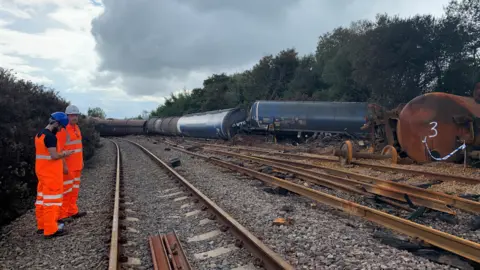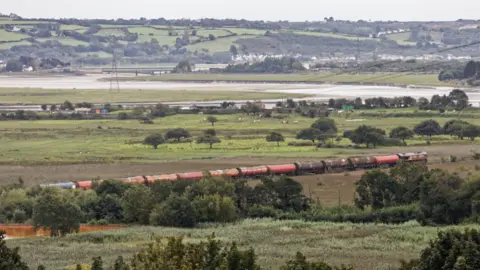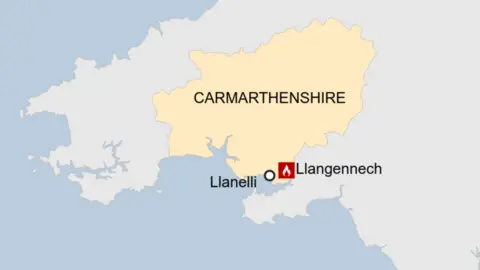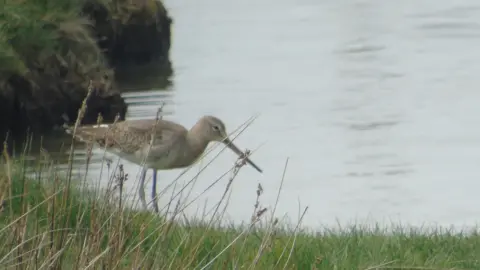Llangennech train fire: Up to 750 tonnes of oil in derailed wagons
There are fears for wildlife after a train carrying up to 750 tonnes of diesel derailed, causing an oil spill at a scientifically important site.
The freight train derailed and caught fire in Llangennech, Carmarthenshire, on Wednesday night.
Ten wagons, each containing up to 75 tonnes of diesel, derailed, with oil spilling into the Loughor Estuary.
Natural Resources Wales (NRW) was not able to investigate the impact until the fire was put out.
NRW officers are now on site to advise on the containment and recovery of the diesel to prevent any further pollution of the estuary.
The site of special scientific interest is home to wildfowl and wading birds.
Ben Wilson, NRW's incident manager, said: "We also have monitoring teams out assessing the extent of the pollution.
"Initial modelling suggests that oil pollution is currently restricted to the upper reaches of the estuary around Loughor Bridge. This is supported by observations on site. We've also seen significant amounts of oil three miles downstream from here.
"We're also keeping partner organisations and people who have interests within the area, such as farmers and cockle licence holders, informed of the situation."
On Friday, the Rail Accident Investigation Branch, which is examining the cause of the incident, said 10 wagons had derailed.In a statement it said the derailment and damage to the wagons had "resulted in a significant spillage of fuel and a major fire".
At the time of the incident, the freight train was carrying 25 tank wagons, 10 of which derailed.
Mid and West Wales Fire and Rescue Service finally extinguished the blaze at about 08:30 BST on Friday, just over 33 hours after the train derailed.

Bill Kelly, route director at Network Rail, said teams had now been granted "limited access" to the site.
"The site has been extensively damaged. We are dealing with a very complex setting, both industrially and also environmentally," he said.
"But we have all the right specialist teams on the ground and we will continue to support our colleagues."
A spokesman for environmental risk reduction specialist Adler and Allan said their first task was to "mitigate further contaminants".
"We've had to gain access through the train, proving a bit difficult, but we're in the middle of getting there," he said.
'It could have a devastating impact'
 Athena Pictures
Athena PicturesThe Loughor Estuary is part of the Carmarthen Bay and Estuaries Special Area of Conservation.
Richard Pryce, from the Llanelli Naturalists group, said the diesel spill could have a "devastating impact" on the local environment.
He said: "The Loughor Estuary is a very important site for its birdlife. It's a European protection site, a special area of conservation, which means it's of European significance because of the large populations of wildfowl and waders.
"If there's oil spilling into the estuary it could have a devastating effect on the birdlife there.
"Diesel is very toxic to the environment so wherever it's spilt, it can be a big problem."
The area is also a significant site for cockle pickers.
 Pembrokeshire Herald
Pembrokeshire HeraldRobert Griffiths, from the Burry Inlet Handgatherers Association, told BBC Radio Wales Breakfast the diesel spill will have a big impact on him and other cockle pickers financially.
He said: "If you don't work, you can't earn any money to pay your mortgages and your bills etc."
Public Health Wales (PHW) said it was "sensible to avoid contact with diesel or the water in contaminated areas".
PHW's Andrew Kibble said diesel was unlikely to damage people's health at low concentrations, or where exposure is for a short period of time, but urged caution.
"Odours are generally noticeable at concentrations well below those that cause harm, but high concentrations can cause dizziness, drowsiness and headaches," he said.
"If you encounter odours move away from the area and into fresh air."
What happened?
The train was travelling from Milford Haven in Pembrokeshire to Theale, near Reading, when it derailed at 23:20 on Wednesday night.
The subsequent fire led to 300 people in the area surrounding the crash site being evacuated from their homes, before being allowed to return on Thursday.

The two crew members on board the train were not injured.
The Rail Accident Investigation Branch (RAIB) said it was carrying out a preliminary examination and gathering evidence.
Why is the Loughor Estuary important?

- The River Loughor's estuary, along with the Burry Inlet to the west, is designated as a site of special scientific interest
- Its habitat of tidal mudflats, saltmarsh - the largest continuous area in Wales - and rockpools offer important wildlife habitat
- Species of wading birds and wildfowl include oystercatcher, curlew, lapwing, little egret, widgeon, dunlin, plover and teal
- The estuary is known for its fishing grounds, for the likes of flounder, bass and mullet
- Further west, the Burry Inlet's cockle beds are well known, with the industry the third largest in Britain
- In that same area is the WWT Llanelli wetland centre, a popular place for spotting wading birds and wildfowl and the 450 acres of grounds.
